Art is an odd commodity.
At one end of the blue chip spectrum, its value in financial terms can be astronomical. It’s very production in terms of materials, scope, studio assistants, transportation, and display, is costly. For members of Inspirations Studio, a Toronto-based ceramics program and studio, the act of creating has immeasurable value beyond the price tag at a Sotheby’s auction.
The ability to access the materials is provided with little to no barriers. The Studio is a safe space where marginalized women working through a myriad of issues related to trauma, poverty, mental and physical health challenges or homelessness, can come and work with clay. By democratizing art to achieve the United Nations Sustainable Development Goal for Reduced Inequalities and centring the mental and emotional needs of women to meet the goal for Gender Equality, Inspirations Studio is shaping new possibilities for its members.
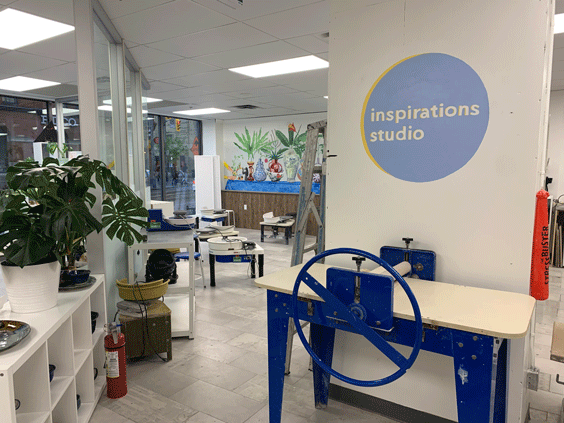
Inspirations Studio recently upgraded to a larger space, where Canadian art stars Shary Boyle and Rajni Perera collaborated on a mural to celebrate its new opening. I had the opportunity to speak with Gudrun Olafsdottir, Director of Inspirations Studio, about the mission of the community-based initiative, and Shary Boyle, advising board member and advocate, about her reasons for supporting the Studio.
Can you tell me a bit about Inspirations Studio and its goals?
At the Studio, women can work out their traumas and heal with clay. We also assist women with improving their lives through the making and selling of the pottery they create. The program starts off with an 8-week course where women come in for an interview to see if this is the right fit for them and then apply to become members. Membership allows them one or two afternoons a week of free studio access. Members also act as mentors to new women who join the program. We’ve been in operation for 27 years and have had three locations in Toronto — this location is our most recent.
The process of making something with your own hands allows marginalized women the opportunity to take control over some aspect of their lives. They can focus on the creative process to reshape their lives in the same way they reshape clay to create something beautiful. Eighty-percent of the sale of our items goes to the maker, so not a lot comes back to us that way. Individual donors and government grants are the backbones of our operation, and we wouldn’t be here without them. We’re especially grateful to donors who give us unrestricted funding to do what we need to do. No strings attached.
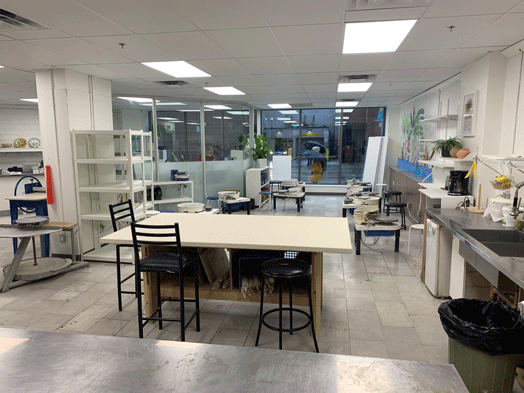
Why did you move to this new space, and what are its benefits?
The new space is bigger than anything we’ve had before, with large storefront windows facing the main strip. It gives us more room to grow the program and accommodate more women. It’s an exciting juncture at this time because it also enables us to have workshops with other agencies. The storefront is built into the base of a newly renovated (by The City of Toronto) YWCA apartment building that provides affordable housing for 120 women, many of whom are also living on the margins. They’ve received grants from the city (Toronto Arts Council) and province (Ontario Arts Council) to provide workshops for the women in the building, with the hope being some will choose to become members.
The old space was so small that it would’ve been impossible to continue operating through COVID-19 restrictions. Even prior to the pandemic, the program was in a precarious position. Inspirations Studio had reached out in past to partner with the YWCA, but that didn’t actually translate into an opportunity at the time. However, the YWCA reached out to Inspirations Studio after they took over this building, and offered us space. Although the Studio is not a programme of the YWCA, our partnership is a perfect pairing.
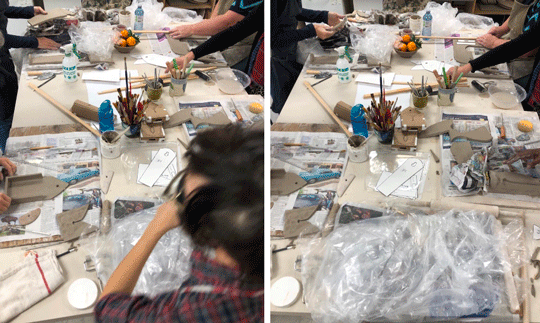
Can you tell me about the women who make up the membership of Inspirations Studio?
Although the membership includes women living in the building, many others find the program through their social workers, doctors or shelters. Community engagement is a huge part of the agenda of Inspiration Studios as well as reducing stigma one pot at a time. Having a storefront that invites people in is an important relationship to have between the makers and the public. There are many members who start the programme with a negative self-image or identity which is transformed over the course of creating.
There are so many ways of experiencing marginalization. It may be a physical challenge, homelessness, or mental health challenges, with the common denominator being trauma of some kind. A really important thing about this program is it allows people to find purpose, passion and pride.
They put a lot of effort into getting good at making pottery, so it’s very exciting when a customer walks through the door and buys a piece from them for the first time. The customer also gets the benefit of owning a beautiful piece of work. Also, what do people know about women who are impacted by trauma or homelessness? Not much. When they come into our store, they see people making beautiful things. We also have open houses where people can meet the maker and engage with women they maybe otherwise wouldn’t.
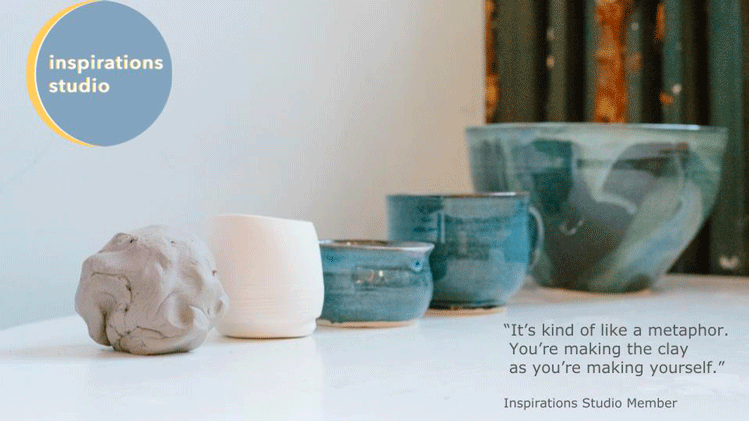
What are the therapeutic properties of working with clay?
There’s something about clay coming from the earth — the notion of working with something that’s tactile and grounding. Just manipulating it feels good. The image on our business cards has a ball of clay on one end that progresses towards bigger and bigger bowls.
One of our members saw the card and said, “you’re making yourself as you’re making the clay,” which I thought was a beautiful metaphor to describe the program. Just sitting at the pottery wheel with a piece of clay requires you to first center the clay, which in a way requires you to focus and center yourself. There’s meditative mindfulness that results from the act. There’s nothing else you can really think about in order to be successful at pottery.
There are so many steps in building pottery. You center it, pull up the walls, and have to be careful to open it up so it doesn’t fall over. One of our members has mentioned there are always cracks and things that will go wrong, but you learn it’s not the end of the world. There’s always this life-skill-building; the ability to focus and make decisions. You’ve decided to become good at something. You have a passion.
Many women will begin coming in with ideas, which means they are taking the time to learn outside of the studio. Learning the creative process and about their ability. Another of our members said to me, “Now I’m not just my mental illness. I’m a potter.” It’s a different way to identify as something else.
So we know how this benefits the members, but what would you say are the beneficial impacts to the broader community?
I’ve noticed that, at least since we’ve moved here, people will come up to our storefront and express how happy they are to see us here. You know, we’re not just another cannabis dispensary. We are a creative space where you can see people in the act of making. We’ve beautified this corner. We offer community classes for the public too. Everyone has struggled over the course of the last two years and the proceeds from those classes go towards supporting the Studio.
Shary Boyle
"It’s hard in Canada to get people behind arts because there’s sometimes a misconception that the arts are a frill or the product of a luxury society. The connection between the arts and physical, mental and community health are coming much later to people’s understanding here. There are other societies and cultures around the world that already grasp that understanding. I see the benefits in both my own practice and life, and I see it in the lives of the members here too," says Boyle.
"I’m a board member because I really believe in the benefits of practicing arts and its importance in helping develop identity, a sense of self and wellness. I have a studio that’s right beside the last location of the Studio. I ducked in one day to see what was going on and as soon as I met the members at work, I immediately wanted to volunteer my services. When I found out the Studios were in danger, I knew I couldn’t allow that to happen."
"I'm more from this rarified space in the art world where there is more money with a smaller sector of people placing a high value on the production of visual arts with expendable income. So I jumped on the board and tried to encourage people in the art world to support art in a way that’s more inclusive and benefits their city in a more vital way."
"Art shouldn’t be a frill, it should be a basic human right."
Rajni Perera
“It's been my honour and pleasure to serve Inspirations Studio. I would like this to be just the beginning of my involvement with this wonderful enterprise. We must follow the studio's example and consider how we can be of service to others, especially those who need a helping hand,” says Perera.
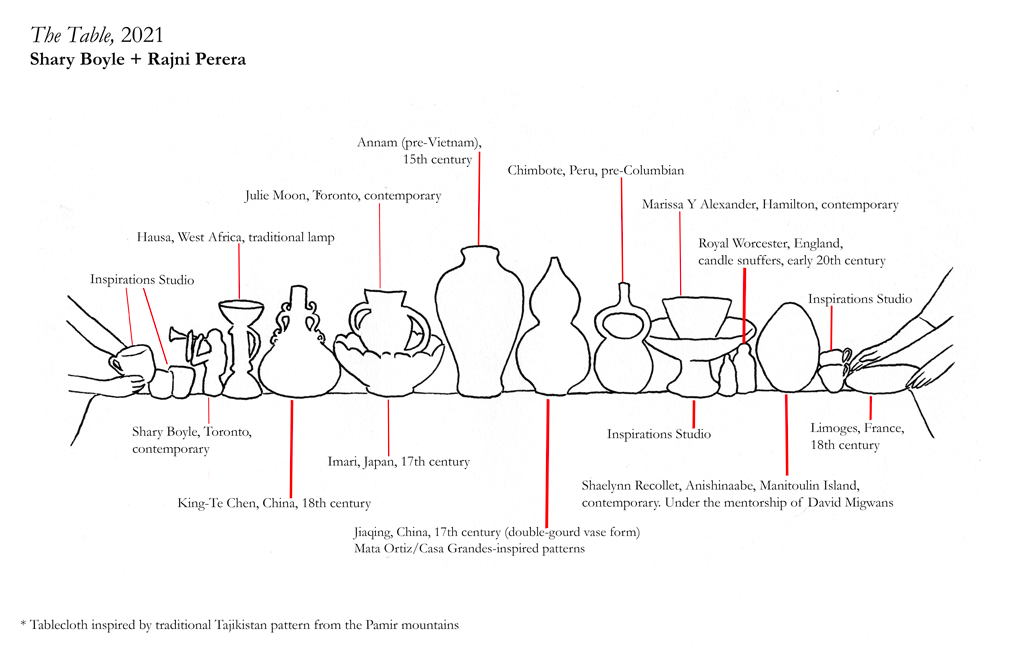
Boyle and Perera's Mural
"So often in the public art sphere, you’ll see work at new condos and financial districts that are loopholes for tax breaks. What aren’t we making beautiful art for people who are going to be sitting in here every day themselves making new art for the community? People walking by will stop in front of the studio and look through the windows. I asked Rajni if she wanted to collaborate and she said sure. It’s a table with world ceramics. Clay is one of the first classic materials people all over the world have used and we all have cultural ancestry with clay. It’s bonding and inclusive," explains Boyle.
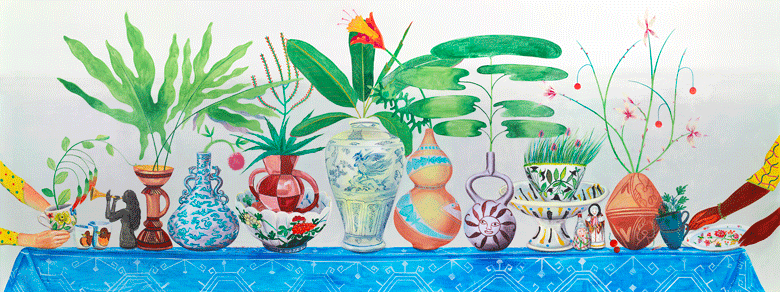
"We also wanted to incorporate the locals through the idea of the table. We’re always talking about “making room at the table” and this mural represents that idea. There are aspirational things that look at the highest achievements of our culture to homey, small, everyday things that are for everybody. It includes cultures from around the world and all the people who live in the city. It also includes a nod to local artists. I did all the vessels. Rajni is a freestyle genius who did all the greenery, plants and lines.”
To learn more about Inspirations Studio, click here. To donate to their cause, click here.
